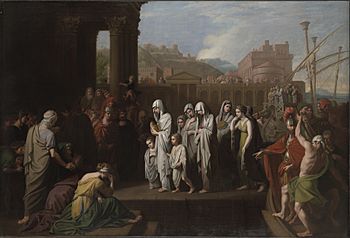Agrippina Landing at Brundisium with the Ashes of Germanicus facts for kids
Quick facts for kids Agrippina Landing at Brundisium with the Ashes of Germanicus |
|
|---|---|
 |
|
| Artist | Benjamin West |
| Year | 1768 |
| Medium | Oil on canvas |
| Dimensions | 164 cm × 240 cm (64.5 in × 94.5 in) |
| Location | Yale University Art Gallery, New Haven |
Agrippina Landing at Brundisium with the Ashes of Germanicus is a famous painting from 1768. It was created by the artist Benjamin West. The painting shows a sad moment in ancient Roman history.
It features Agrippina the Elder, a Roman noblewoman. She is arriving in Brundisium, Italy, with the ashes of her husband, Germanicus. She is there to perform his final funeral rites. The way Agrippina and her children look in the painting is based on old Roman sculptures. These sculptures are from a monument called the Ara Pacis Augustae. The buildings in the background are inspired by drawings of ancient Roman ruins. These drawings were made by Robert Adam.
The Story Behind the Painting
Germanicus was a very important Roman general. He was the adopted son of Tiberius, the second Roman emperor. Germanicus was meant to be the next emperor. He was sent to manage the eastern parts of the Roman Empire. There, he had a disagreement with Gnaeus Calpurnius Piso. Piso was the governor of Syria.
Germanicus became ill during this time. He sadly passed away on October 10, AD 19, in Antioch. Many people believed he had been poisoned. Piso was later put on trial for his actions.
After Germanicus was cremated in Antioch, Agrippina carried his ashes herself. She brought them all the way back to Rome. This journey was a time of great sadness for the Roman people. Huge crowds of people came to meet her when she landed at the port of Brundisium. The emperor even sent a special guard to protect her. As she traveled through each town, people came out to show their respect. Important Roman figures, like Tiberius's son Drusus the Younger, joined the procession. Once she reached Rome, Germanicus's ashes were placed in the Mausoleum of Augustus.
Germanicus was a very popular general. He was seen as an ideal Roman citizen even after his death. Ancient writers like Suetonius and Tacitus often compared him to great leaders. They praised his good qualities. They often contrasted him with Emperor Tiberius, who was seen as a harsh ruler. Agrippina continued to honor Germanicus after he died. A historian named Lindsay Powell said that Romans saw her as "the glory of the country." She was also called "the only surviving child of Augustus" and "a rare example of the good old times."
What the Painting Shows
Agrippina Landing in Brundisium with the Ashes of Germanicus is a large painting. It is made with oil paints on a canvas. The painting shows the events described in an ancient Roman book by Tacitus. The artist, Benjamin West, heard this story from a client, Dr. Robert Drummond.
The painting shows Agrippina arriving in Italy with her children. She is holding the ashes of her husband, a Roman hero. She stands in front of a crowd of people who are mourning. Agrippina's appearance in the painting is based on old Roman art. She was meant to represent strong Roman values and self-control.
West carefully arranged the buildings in the background of the painting. They look like the drawings from Robert Adam's book. Adam was an archaeologist. He visited the Palace of Diocletian to study its architecture. He then recreated it in his drawings.
History of the Painting
Dr. Drummond read stories from Tacitus to Benjamin West. He also shared his own thoughts on the events. West was very excited about this project. He loved the neoclassical art style, which looked back to ancient Greek and Roman art.
The painting was shown to the public in 1768. King George III liked it very much. At this time, there was a lot of political discussion in the royal court. The painting became popular because it seemed to connect to the King's mother, Princess Augusta of Saxe-Gotha. It showed a grieving widow, much like the King's mother might have felt. Before this painting, Agrippina's story was not well known in art.
King George III was so impressed by the painting's historical accuracy. He asked West to paint another picture for him. This painting was called The Departure of Regulus from Rome. Agrippina was later shown at the first exhibition of the Royal Academy in 1769. West continued to paint many more works for the King over the years.
Agrippina became a famous example of noble grief in art during the 1700s. However, art styles changed later. In the Victorian period, artists started to show grief in more emotional ways.
The painting was later given to the Yale University Art Gallery. It was a gift from Louis M. Rabinowitz. The painting is still there today.

